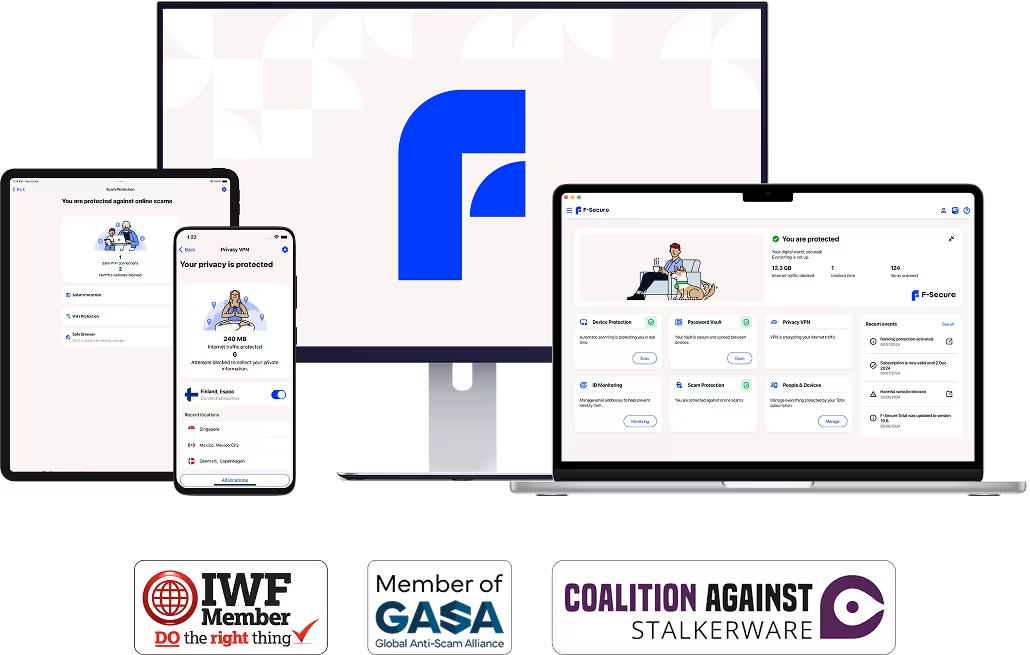Try Scam Protection FREE for 7 days! 30-day money-back guarantee.

Scam Protection: Say goodbye to online scams
Explore our expert scam prevention advice and resources to keep yourself and your family safe from cybercriminals
Try Scam Protection for freeLearn how online scammers operate
Unfortunately, online scams are evolving faster than ever, leaving many of us feeling vulnerable or worrying about our less tech-savvy friends and relatives. Last year alone, it’s estimated that US citizens lost a combined $12.5 billion due to cybercrime, which is a 12% increase year-on-year.
That’s why F-Secure has put together these resources to help you navigate the world of digital con artists and their favorite playgrounds: email inboxes, text messages, shopping sites, and even your credit cards. By understanding scammers’ tactics, you and your family will be better equipped to spot these tricksters from a mile away.
Ever opened your inbox to find it flooded with suspicious emails? You’re not alone! Email scams have become a persistent menace and they aren’t going anywhere soon.
Email scammers are using increasingly sophisticated tactics to trick unsuspecting victims. From ultra-targeted phishing attacks to elaborate gift card redemption schemes, the prevalence of email scams serves as a stark reminder to never let your guard down online.
Phishers often send emails that mimic legitimate companies. They exploit your trust, hoping you’ll hand over passwords or credit card details. Remember, reputable businesses won’t ask for sensitive data via email. When in doubt, contact the supposed sender before you click that link!
Creating a sense of urgency is a classic move in the email scams playbook! Email scams want to push you to act before you think. Take a deep breath and remember: legitimate organizations give you time to verify. Don’t let email scammers get past your common sense!
Virus-bearing attachments are a favorite trick in the world of online scams. They might pose as invoices, resumes, or even cute cat pictures, but once opened, they can unleash malware, compromising your device and data. If you aren’t expecting an attachment, verify with the supposed sender through a separate, trusted channel.

Ding! Another text message. But wait, is it from your bank or a sneaky scammer? SMS scammers are getting craftier by the day, always thinking of creative new ways to trick you into parting with your data. From fake delivery alerts to “urgent” account warnings, they’re fishing for your personal info, so don’t fall for it! Remember, when it comes to texts, skepticism is the way forward.
“Smishing” is just like phishing, but via SMS. Scammers send you messages pretending to be your bank or another legitimate organization, but really they’re angling for your personal info! Legit organizations never ask for sensitive details via text. Don’t respond.
Received a text from a suspiciously short number? Short code SMS scammers sometimes use brief digits to appear more official, and use tempting hooks like prizes to elicit a response. Resist the urge! Answering could lead to unauthorized charges on your phone bill or even data theft.
A text from Mom asking for money. Seems legit, right? Not so fast! In this twist on text message scams, fraudsters clone or spoof familiar contacts. They’re banking on your trust to bypass your scam radar. Always verify unusual requests through a different communication channel!

Attention, shoppers! The digital marketplace is a treasure trove of deals, but beware – it’s also a playground for scammers and con artists. From too-good-to-be-true discounts to fake websites mimicking your favorite brands, online shopping scams are lurking in every virtual aisle. Especially during times of increased shopping traffic like “Cyber Monday”, make sure your scam radar is on high alert while you hunt for those killer deals!
Fake reviews are a common tool for online shopping scammers. Armies of bogus accounts shower praise on shady products or bash legit ones, looking to convince you to buy their shoddy goods or steer you away from competitors. No bad reviews? Dig deeper before buying.
AI video has come on leaps and bounds in recent years, and scammers are catching up! From stunning videos of crystal carved mugs to incredible celebrity endorsements, be aware that “Deep Fakes” are everywhere. Always read video comments, and be sure to shop around!
Discounted gift cards?! Yeah, it’s probably too good to be true! They’re often stolen or empty, or worse, a scammer might ask you to pay with gift cards – a huge red flag! Boost your scam protection by only buying gift cards from authorized retailers.

Virtual pickpockets are everywhere, from fake shopping sites to sneaky data breaches. Online credit card scammers are after your precious plastic, ready to go on a spending spree faster than you can say “declined.” With new tricks popping up daily, staying one step ahead of these digital bandits is the name of the game!
In “Formjacking”, online credit card scammers inject malicious code into legit websites, silently stealing your card details as you type them. Protect yourself by using virtual credit cards online purchases and keeping your antivirus up to date!
Someone slid into your social media DMs, promising easy money if you share your card details? Don’t be duped! They’re after your hard-earned cash and pristine credit score. Boost your scam protection by treating your card details like your deepest secrets – never, ever share them!
Scammers are tech-savvy, and can hijack your device’s DNS settings, redirecting you from real online stores to convincing fake websites. The best way to protect against DNS switches is by double-checking website URLs before you input your details, and always using secure Wi-Fi!


Go behind the scenes of a scammer — from stealing personal information through data breaches to committing shopping fraud using phishing emails and text messages. Your data could only be a click away.

See how personal identity theft can get. Banking credentials, location data, and even medical histories — all of this personal information can be bought on the dark web. Fraud prevention has never been more crucial.
Scam Protection for the whole family
Keep you and your loved ones safe from online scams. Try F-Secure Scam Protection on your mobile devices and computers for free.
Try 7 days for freeGauge online threat levels with the F‑Secure Scamometer
Use our free Scamometer to assess which online activities are most at risk from sneaky scammer attacks.
Try nowCould you be scammed on your favorite online platform
From Amazon and eBay’s sophisticated phishing schemes to Temu’s data privacy concerns and Instagram’s fake seller profiles, scammers are constantly evolving their tactics and the platforms you trust most might be where you’re most vulnerable. But with the right knowledge and tools, you can shop confidently while keeping your personal information and money secure. Discover the most common scams plaguing your favorite platforms and learn how to protect yourself before becoming another statistic.
The best defense against online scams is a proactive approach:
- Always enable two-factor authentication
- Use unique passwords for each platform
- Pay through protected methods — never with gift cards or direct bank transfers
Before making purchases, verify seller ratings, research pricing across platforms, and trust your instincts when deals seem too good to be true!
For detailed guides on recognizing and avoiding scams on specific platforms, explore our comprehensive protection resources below.
Protect yourself from online scams — try F‑Secure Scam Protection for FREE for 7 days
F-Secure Scam Protection keeps you and your loved ones safe from online scams, and to prove it we are giving you 7 days to try it out for free. After the trial period the subscription will continue for only €4.99 per month unless you cancel it.
)
Avoid online banking scams
Block phishing sites and malicious links
Filter and block SMS scam messages instantly
Protect 5 devices with a single subscription
Cancel anytime
Free customer support
After trial only €4.99/month
30-day money-back guarantee — no questions asked
After 7 days your trial will turn into a monthly subscription at €4.99 per month unless cancelled. All prices include VAT. Cleverbridge GmbH is the F‑Secure reseller and your partner for any trial or purchase in our online store.
Frequently asked questions
F-Secure has been a driving force in the cyber security industry for more than 30 years. A member of the Internet Watch Foundation (IWF), the Global Anti-Scam Alliance (GASA) and the Coalition Against Stalkerware, we are at the forefront of threat intelligence through extensive research developed by F-Secure experts, and we’re dedicated to educating people on how to protect themselves from scams.
Select a digital moment from the drop-down list to learn about potential scam risks and threat levels for that online activity. These Scamometer outcomes were developed through the expertise of F-Secure cyber threat experts and data collected from our Living Secure survey. The overall threat level for each outcome is informed by the impact and probability scores determined by our experts.
The F-Secure Scamometer explores threat levels across a range of everyday digital moments targeted for online scams: dating, shopping, banking, gaming, voice calls, and text messaging.
- A higher score (4–6) indicates a higher impact on life, probability, and/or overall threat risk.
- A lower score (1–2) indicates a lower impact on life, probability, and/or overall threat risk.
The tool also provides examples of scam scenarios to watch out for during each online activity.
Today, almost everything we do is digital — from paying bills and banking online to online shopping and dating. And scammers have capitalized on this, using a variety of tactics in their scams to trick people. These include:
- Emotional manipulation
- Fearmongering
- Time pressure
- Gaining victims’ trust
In recent years, scammers have taken advantage of artificial intelligence (AI) advancements to craft compelling phishing messages and even manipulate audio, images, and videos. For example, AI-enhanced phishing scams are commonly used by scammers to steal personally identifying information, such as your social security number or bank account details, for identity theft.
Browse our articles to learn about the latest online scams and how to protect yourself.
You could encounter a range of scams in your digital life, such as:
- Online dating: fake profiles, romance scams, and investment scams
- Online shopping: fake deals/discounts, shops, and shopping apps.
- Online banking: phishing scams, credit card cloning, and banking app trojans.
- Gaming: bad trades, fake apps and mods, and skin in the game scams.
- Text messaging: smishing, subscription traps, and misleading promotions.
- Voice calls: social engineering calls, robocalls, spam phone calls, and voice spoofing.
Browse our articles to learn about the latest online scams and how to protect yourself.
Yes, by taking care of your cyber hygiene and remaining vigilant online, you can avoid scams.
- Use our free tools to avoid scams by checking the legitimacy of online shops and text messages, creating strong and unique passwords, and much more.
- Take advantage of F-Secure Total, our comprehensive cyber security solution that makes protecting your digital life effortless with one brilliantly simple app.
- Browse our articles to learn about the latest online scams and how to protect yourself.
To protect yourself from scams, it’s essential to stay informed about the latest scammer tricks and scam protection advice, and to be vigilant when sharing personal information online. Always verify the legitimacy of any unsolicited communications and never click on suspicious links or download attachments from unknown sources.
In today’s digital age, scammers are becoming increasingly sophisticated in their tactics. They use a variety of methods to deceive unsuspecting victims including phishing emails, fake websites, and fraudulent job offer scams, which can lead to significant financial losses and personal information theft. Be cautious of any requests to send money and remember the golden rule in scam protection and prevention: if something seems too good to be true, it probably is. Furthermore, if something doesn’t feel right, it’s time to stop and reassess the situation. Consider the following:
- Are you being asked to move or transfer money or reveal personal information?
- Are your emotions (such as fear) being manipulated to coerce you into acting quickly?
- Have you received an unexpected call or request from someone — or something — you trust, such as your bank, a government official, a colleague, or even a family member?
If you think you’ve fallen victim to a scam, you should do the following:
- Record the details of the scam. Take any screenshots, note specific information such as URLs or phone numbers, and list any payments you may have made.
- Report it to the appropriate authorities, depending on where you live. If you live in the US, you should report a scam to the Federal Trade Commission and the Better Business Bureau. In the UK, you should report a scam to Action Fraud. In countries such as Finland, Sweden and Germany, you should report it to the police. Visit Europol for a full list of places to report an online scam in European countries.
- Contact your bank if you’ve provided financial information or made an online purchase.

